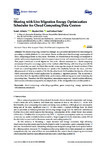Sharing with live migration energy optimization scheduler for cloud computing data centers
| dc.contributor.author | Alshathri, S | |
| dc.contributor.author | Ghita, B | |
| dc.contributor.author | Clarke, Nathan | |
| dc.date.accessioned | 2021-09-28T10:01:44Z | |
| dc.date.issued | 2018-09-06 | |
| dc.identifier.issn | 1999-5903 | |
| dc.identifier.issn | 1999-5903 | |
| dc.identifier.other | 9 | |
| dc.identifier.uri | http://hdl.handle.net/10026.1/17959 | |
| dc.description.abstract |
© 2018 by the authors. The cloud-computing concept has emerged as a powerful mechanism for data storage by providing a suitable platform for data centers. Recent studies show that the energy consumption of cloud computing systems is a key issue. Therefore, we should reduce the energy consumption to satisfy performance requirements, minimize power consumption, and maximize resource utilization. This paper introduces a novel algorithm that could allocate resources in a cloud-computing environment based on an energy optimization method called Sharing with Live Migration (SLM). In this scheduler, we used the Cloud-Sim toolkit to manage the usage of virtual machines (VMs) based on a novel algorithm that learns and predicts the similarity between the tasks, and then allocates each of them to a suitable VM. On the other hand, SLM satisfies the Quality of Services (QoS) constraints of the hosted applications by adopting a migration process. The experimental results show that the algorithm exhibits better performance, while saving power and minimizing the processing time. Therefore, the SLM algorithm demonstrates improved virtual machine efficiency and resource utilization compared to an adapted state-of-the-art algorithm for a similar problem. | |
| dc.format.extent | 86-86 | |
| dc.language | en | |
| dc.language.iso | en | |
| dc.publisher | MDPI | |
| dc.subject | 7 Affordable and Clean Energy | |
| dc.title | Sharing with live migration energy optimization scheduler for cloud computing data centers | |
| dc.type | journal-article | |
| dc.type | Journal Article | |
| plymouth.issue | 9 | |
| plymouth.volume | 10 | |
| plymouth.publication-status | Published online | |
| plymouth.journal | Future Internet | |
| dc.identifier.doi | 10.3390/fi10090086 | |
| plymouth.organisational-group | /Plymouth | |
| plymouth.organisational-group | /Plymouth/Faculty of Science and Engineering | |
| plymouth.organisational-group | /Plymouth/Faculty of Science and Engineering/School of Engineering, Computing and Mathematics | |
| plymouth.organisational-group | /Plymouth/REF 2021 Researchers by UoA | |
| plymouth.organisational-group | /Plymouth/REF 2021 Researchers by UoA/UoA11 Computer Science and Informatics | |
| plymouth.organisational-group | /Plymouth/Users by role | |
| plymouth.organisational-group | /Plymouth/Users by role/Academics | |
| dcterms.dateAccepted | 2018-07-25 | |
| dc.rights.embargodate | 2021-9-29 | |
| dc.identifier.eissn | 1999-5903 | |
| dc.rights.embargoperiod | Not known | |
| rioxxterms.versionofrecord | 10.3390/fi10090086 | |
| rioxxterms.licenseref.uri | http://www.rioxx.net/licenses/all-rights-reserved | |
| rioxxterms.licenseref.startdate | 2018-09-06 | |
| rioxxterms.type | Journal Article/Review |


